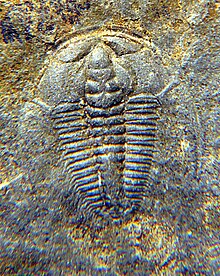| Redlichia chinensis | |
|---|---|

| |
| Scientific classification | |
| Domain: | Eukaryota |
| Kingdom: | Animalia |
| Phylum: | Arthropoda |
| Class: | †Trilobita |
| Order: | †Redlichiida |
| Family: | †Redlichiidae |
| Genus: | †Redlichia |
| Species: | †R. chinensis |
| Binomial name | |
| †Redlichia chinensis (Walcott, 1905) | |
Redlichia chinensis is an extinct species of trilobite that existed from 526 million years ago to 513 million years ago in the early Cambrian period (4th stage).
Ecology
The species is a nektobenthic deposit feeder.
History
R. chinensis was discovered by Chang in 1966 in the Balang formation, China. 19 fossils have been discovered.
Morphology
R. chinensis has a wide cephalon with a border and the glaella tapers forwards. The hypostoma has been pushed through from the underside and the genal spines are not at the occipital edge. The thorax narrows to a small pygidium and the pleurae terminate in short spines. R. chinensis is 7.5 centimeters long.
References
- Kobayashi, T.; Kato, F. (1951). "On the ontogeny and the ventral morphology of Redlichia chinensis with description of Alutella nakamurai, new gen. and sp". Journal of Faculty of Science, University of Tokyo. 2 (8): 99–143.
- "Redlichia (Pteroredlichia) chinensis (Walcott 1905) - Encyclopedia of Life". eol.org. Retrieved 2022-07-03.
- "Fossilworks: Redlichia (Pteroredlichia) chinensis". Paleobiology Database. Retrieved 2022-05-29.
- "Science Source Stock Photo - Redlichia chinensis, Cambrian trilobite fossil". www.sciencesource.com. Retrieved 2022-07-03.
| Taxon identifiers | |
|---|---|
| Redlichia chinensis | |
| This article needs additional or more specific categories. Please help out by adding categories to it so that it can be listed with similar articles. (May 2022) |
This Redlichiida-related article is a stub. You can help Misplaced Pages by expanding it. |